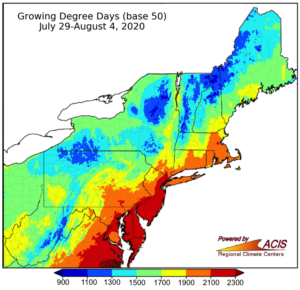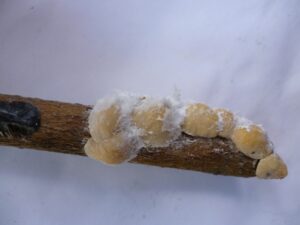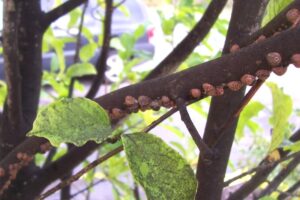This PPA has four updates:
- Growing Degree-day Update GDD50
- 2nd generation scale insect hatch / crawler growing degree-day targets
- Tuliptree and Magnolia scale insect activity and notes on treatment
- Late summer boxwood blight considerations
(1) Growing Degree-days as of 8/5/2020
(Weather station selected for each location. Ex: NJ50 = Upper Deerfield)
Upper Deerfield (NJ50)= 2242 GDD50 Howell/Freehold (NJ10) = 1946 GDD50 Pequest (NJ58) = 1901 GDD50

If you need help getting your Growing Degree-day models set up, please contact (twaller@njaes.rutgers.edu)
(2) 2nd generation scale insect hatch / crawler GDD50 targets
A second generation of scale insects will be hatching soon. Scout for crawlers and treat as needed.
format: scale insect species – (growing degree day GDD50 targets)
- Maskell scale – (2035)
- Euonymus scale – (2235)
- Japanese maple scale – (2508)
Please refer to Tim Waller’s summer scale insect treatments PPA for additional information.
(3) Tuliptree and Magnolia scale egg hatch and crawler activity

Magnolia Scale & Maturing Females Photo- Steven Rettke of RCE

Tuliptree Scale With Honeydew & Sooty Mold Photo- Steven Rettke of RCE
Tuliptree scale and Magnolia scale insects begin hatching around ~2000 GDD50 but continue to emerge through the month of September (+6 week period). Therefor scouting for 1st and 2nd instar nymphs (crawlers) is critical to controlling these pests. Treatments will be ineffective if made too early in the season, as many of the un-hatched eggs will still be viable and lead to infestation and damages later.
Given this wide window of emergence, three treatment strategies can be deployed
- Delay pesticide applications for these pests until mid-October as the females will be dead and not harming the trees, all of the eggs will have hatched, and all of the crawlers will be vulnerable to appropriate materials (best approach)
- Apply multiple suppressive sprays at the first sign of emergence (time consuming, labor intensive, costly)
- Root or trunk applied systemic insecticides (often for very large trees)
Please refer to Steve Rettke’s Magnolia and Tuliptree scale insect PPA for additional information.
(4) Late summer boxwood blight considerations
As we enter into a period of cooler nighttime temperatures (< 77F) and frequent rain events, boxwood blight preventative sprays should be considered if you have not been making regularly scheduled applications. Boxwood blight is typically not as active during the heat of the summer, however, when cooler temperatures are coupled with prolonged periods of leaf-wetness the pathogen can infect.
Please refer to Tim Waller’s boxwood blight post for additional information and links to many other resources including numerous post from Rich Buckley of the Plant Diagnostic Lab.
Please take the 2020 Nursery Industry Survey: https://forms.gle/dUjLxaiu6qDQYYsRA

